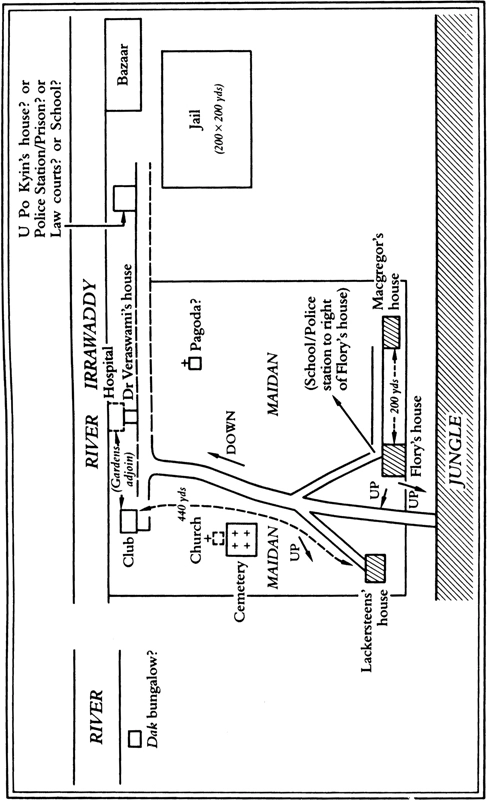Burmese Days

GEORGE ORWELL
Burmese Days
This desert inaccessible
Under the shade of melancholy boughs.
As You Like It
with an Introduction by Emma Larkin
and A Note on the Text by Peter Davison

BookishMall.com
Contents
INTRODUCTION TO BURMESE DAYS
A NOTE ON THE TEXT
Chapter I
Chapter II
Chapter III
Chapter IV
Chapter V
Chapter VI
Chapter VII
Chapter VIII
Chapter IX
Chapter X
Chapter XI
Chapter XII
Chapter XIII
Chapter XIV
Chapter XV
Chapter XVI
Chapter XVII
Chapter XVIII
Chapter XIX
Chapter XX
Chapter XXI
Chapter XXII
Chapter XXIII
Chapter XXIV
Chapter XXV
PENGUIN MODERN CLASSICS
Burmese Days
George Orwell (whose real name was Eric Arthur Blair) was born in 1903 in India and then went to Eton when his family moved back to England. From 1922 to 1927 he served with the Indian Imperial Police in Burma, an experience that inspired his first novel, Burmese Days (1934). He lived in Paris before returning to England, and Down and Out in Paris and London was published in 1936. After writing The Road to Wigan Pier and Homage to Catalonia (his account of fighting for the Republicans in the Spanish Civil War), Orwell was admitted to a sanatorium in 1938 and from then on was never fully fit. He spent six months in Morocco where he wrote Coming Up for Air. During the Second World War Orwell served in the Home Guard and worked for the BBC. His political allegory Animal Farm was published in 1945 and it was this novel, together with Nineteen Eighty-Four (1949), which brought him worldwide fame. George Orwell was taken seriously ill in the winter of 1948–9 and died in London in 1950.
Peter Davison is Research Professor of English at De Montfort University, Leicester. He was born in Newcastle upon Tyne in 1926 and studied for a London External BA (1954) by correspondence course. He edited an Elizabethan text for a London MA (1957) and then taught at Sydney University, where he gained a Ph.D. He was awarded a D.Litt and an Hon. D. Arts by De Montfort University in 1999. He has written and edited fifteen books as well as the facsimile edition of the manuscript of Nineteen Eighty-Four and the twenty volumes of Orwell’s Complete Works (with Ian Angus and Sheila Davison). He is a past president of the Bibliographical Society, whose journal he edited for twelve years. He was made an OBE in 1999 for services to literature. He was awarded the Gold Medal of the Bibliographical Society in 2003 and appointed a Professor Emeritus of Glyndwr University in 2009.
Emma Larkin is the pseudonym for an American writer who was born and bred in Asia. She studied the Burmese language at the School of Oriental and African Studies in London and has been visiting Burma for over ten years. Larkin is the author of Secret Histories: Finding George Orwell in a Burmese Teashop, and is currently working on her second book about Burma.

Key to a sketch-map of Kyauktada that was drawn by Orwell
Introduction to Burmese Days
In Katha, the remote town in northern Burma where George Orwell set Burmese Days, there stands a solitary, pale-orange chimney. The large British house that once stood around it is long gone. On either side of its base there is an empty brick fireplace. Halfway up the chimneystack are the remnants of the second storey – five weathered planks sticking out in all directions like signposts.
In Burmese Days, part of the grassy clearing around the chimney was once a sitting room decorated with ornamental tables and brassware trinkets from India. Orwell wrote that the room had smelled of chintz and dying flowers.
According to my reading of a sketch-map Orwell drew (reproduced on page ii of this edition) to show the real-life geographical setting of Burmese Days in Katha, this chimney is all that remains of the home of Mr Lackersteen, the lascivious gin-swilling sahib, and his wife, the indomitable memsahib forever making kit-kit with her servants and complaining about the heat of the tropics.
Ever since I first visited Katha, Burmese Days has been for me a heady blend of fact and fiction. Based on Orwell’s time in Burma between 1922 and 1927, the novel provides a keen insight into his own experiences there as well as an intimate and damning critique of colonialism written from first hand experience. Though the colonial society that inspired Burmese Days has long-since vanished, all the novel’s key buildings remain much as Orwell described them, and walking through the streets of Katha feels like walking onto an abandoned stage-set.
In my mind, the characters brought to life in Burmese Days are so vividly etched against the backdrop of Burma that it is easy to imagine them haunting the country still.
Before Orwell became a writer, he spent nearly five years working as a policeman for the British imperial police force in colonised Burma. Known then by his real name, Eric Blair, he was a distinctly un-Orwellian character. His background had groomed him to be the quintessential child of empire. His father had been an opium-tax collector in India and his mother, who was born into a prominent family of shipbuilders and teak traders, had had a grand upbringing in Burma tended to by a small army of servants. Orwell himself was born in India, returning to England with his mother before his second birthday. He went to Burma at the age of nineteen, fresh from Eton College.
1 comment